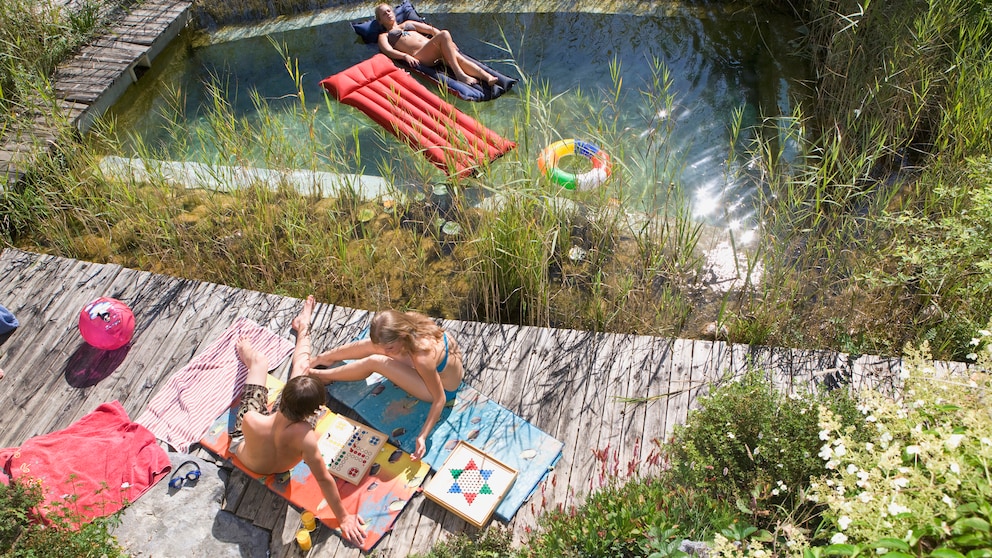April 22, 2025, 8:55 am | Read time: 5 minutes
Drought is a problem in many regions of Germany. Some municipalities have to restrict the use of water. What can owners of pools in their own garden do?
The pool is a favorite place in the garden. But it is criticized because swimming pools swallow up a lot of water—a problem in dry summers. Filling a pool that is 8 meters long, 4 meters wide and 1.35 to 1.50 meters deep requires 30,000 to 48,000 liters of water. What’s more, the heat causes a lot of water to evaporate—so you have to top up the pool water. But there is good news: you can also save water in your pool. Here are the expert tips.
Don’t Refill the Pool Every Year and Save Water
It’s like the real start of summer for pool owners: with the first really warm days of the year, they refill the garden pool. The water from the previous season is drained—if not already done before the winter—and new water is filled in. “But that’s not even necessary,” says Michael Henze from the German Federal Association of Garden, Landscape and Sports Ground Construction. “All you need to do is replace a third of the pool water.”
Ute Wanschura, Managing Director of the German Swimming Pool & Wellness Association, also says: “A complete pool refill is only advisable every five to eight years. However, the prerequisite is that the water in the pool is treated professionally.” It needs a good filter system and water care products.
Cover Greatly Reduces Evaporation
But that may not be enough. Because water evaporates from the pool in hot weather. “In summer, a pool can lose six liters per day per square meter. For a 4 x 8 meter pool with an open area of 32 square meters, that’s 192 liters,” says Ute Wanschura.
So: cover the pool when you’re not using it. “It would be best to leave the pool open for a maximum of one hour a day and cover it for the rest of the day,” says the expert. In this way, evaporation can be reduced to up to one liter per day per square meter.
What About the Garden Pond?
The situation is somewhat different with garden ponds, which are not criticized for being a habitat for many wild animals and improving the microclimate. However, it may be necessary to replenish water levels that have dropped too low in hot weather.
“If the water level drops too much, the plants in the shallow water area are not sufficiently nourished,” explains Jörg Korfhage, gardener and trainer at the DIY Academy in Cologne. “With a lower water level, the water in the pond heats up more, its oxygen content decreases, algae grow more and the fish suffer or even die.” The water level in a pond drops by an annual average of two millimetres and by four to five millimetres in summer. Important: It must not be covered.
Do Not Replace Well-Maintained Pond Water
However, it is not necessary to completely replace the water in a pond. According to Jörg Korfhage, it lasts for years and only needs to be partially drained and replaced if the water quality deteriorates significantly. This can happen when leaves and plant debris accumulate in the water. The gardener therefore advises removing them thoroughly once a year and occasionally as required.
“A garden pond does require a certain amount of maintenance,” says Michael Henze. “But you can reduce it by using the power of plants and planting pond plants such as rushes, sedges, bulrushes, reeds or marsh marigold in low-water zones to purify the water.”
But these can also become a problem. It’s not just the sun and heat that draw water from the pond, but also plants that grow around the water. “If their roots have direct contact with the water surface, the capillary effect kicks in and they suck the liquid out of the pond or pool,” explains Jörg Korfhage. Reeds are particularly thirsty. “It is best to keep the water’s edge clear of plants and not create a direct connection between water and land,” advises the gardener.
If there is a significant loss of water, damage to the pond liner should be considered. “If the water level drops by around ten centimetres within a few days, there is a leak somewhere,” says Jörg Korfhage. Pool liners can also leak. For both pools and ponds, age can play a role: Their liners have an expected lifespan of around 15 years.
Save Pool Water by Using Rainwater
To save treated water, ponds and pools can be filled with rainwater. According to Jörg Korfhage, this is even better for the pond than well water and drinking water. The latter is expensive and may require a lot of treatment to achieve pond water quality. Well water can contain pollutants. You should therefore have it analyzed before using it.
It’s a little more complicated in the pool. “You can generally use rainwater that has been collected in a cistern for the pool,” says Ute Wanschura. But it has to be treated beforehand.

How Do You Create a Stream in Your Garden?

How households can use rainwater

4 Methods for Collecting Rainwater in the Garden
Continue to Use Drained Water
The good news is that even the water that has to be drained from the pool and pond can be reused. “It can be collected and used to water the garden,” says Michael Henze. However, if the pool water still contains chlorine, you should wait a few days before watering the plants. “Chlorine breaks down quickly and is then no longer a problem,” says Ute Wanschura.
with material from dpa

